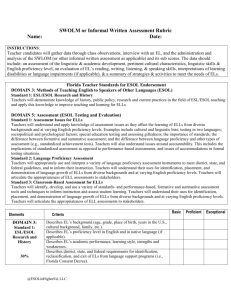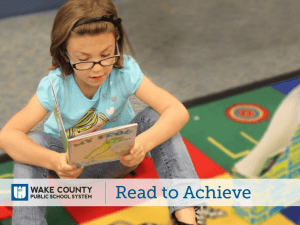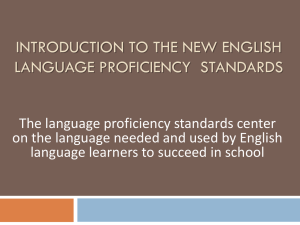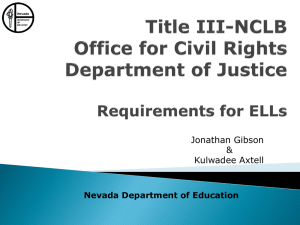Introduction to the Organization of the New Standards
advertisement
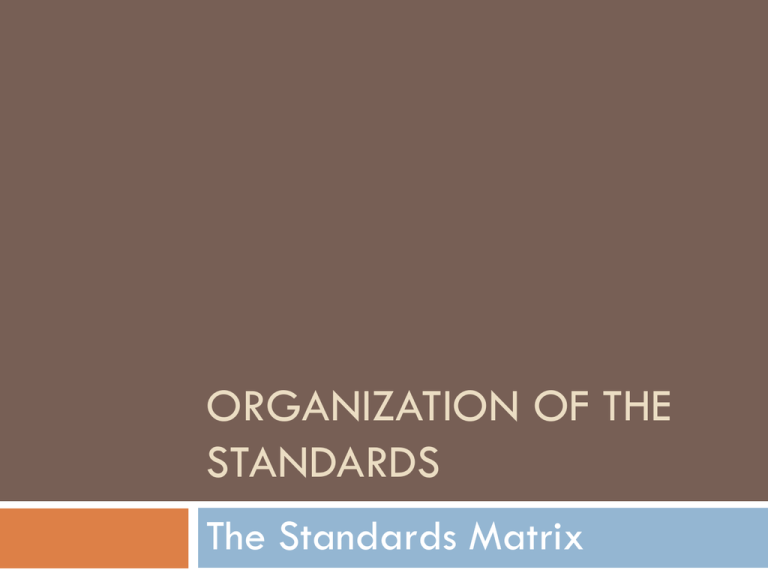
ORGANIZATION OF THE STANDARDS The Standards Matrix Don’t Panic: There will be more detailed training regarding Ways to Implement the Standards and How to Transform the Elements of a Sample Performance Indicator. Language Proficiency in School •Language proficiency is an outgrowth of cumulative experiences both inside and outside of school. •Language proficiency can reflect complex thinking when linguistic complexity is reduced and support is present. •Both social and academic language proficiencies are necessary for school success. •Academic language proficiency goes in tandem with academic achievement. •Academic language proficiency is developed through sustained content-based language instruction. Factors in Academic Language Proficiency Cognitive: Sociocultural: Learning strategies Higher order thinking Knowledge base Affective factors School culture Native language and culture Linguistic: Phonology, grammar, pragmatics, discourse, vocabulary, social and academic language functions, informal and formal registers Topic English Language Proficiency Standards: Level 1 Level 2 Level 3 Level 4 Level 5 Starting Emerging Developing Expanding Bridging Sample Performance Indicator (SPI) Listening Speaking A strand of SPIs Reading Writing Grade Level Cluster A Sample Performance Indicator Grade Level Cluster: 4-5 Standard 4 (the language of Science) Identify – Language Proficiency Level: 2 Language Domain: Speaking The language function Identify information in phrases or short sentences about weather from charts or tables with text. Charts or tables – the type of support Weather The topic or content Uses for the English Language Proficiency Standards The primary use of the English language proficiency standards is to guide and align curriculum, instruction, and assessment for English language learners. Transforming Sample Performance Indicators (SPIs) SPIs can be changed to suit instruction by transforming any of its elements: – Language function – Topic – Domain – Support or strategy Example of a change in language function Grade Level: 1-3 Standard 1 Writing Explain special events or celebrations at school, home, or home country using drawings or graphic organizers Level 4 Compare special events or celebrations at school, home, or home country using drawings or graphic organizers Example of a change in content Grade Level: 4-5 Standard 5 Listening Match artifacts or creatures of the past with their environments based on videos, movies, and oral descriptions Level 2 Match geographic regions with their environments based on videos, movies, and oral descriptions Example of a change in language domain Grade Level: PreK-K Standard 4 Writing Copy or create a list of materials (e.g., for growing seeds) using a combination of drawings, letters, scribble writings, and words with invented spellings. Level 3 Present a list or enumerate materials (e.g., for growing seeds) with a partner Example of a change in language domain Grade Level: PreK-K Standard 4 Writing Copy or create a list of materials (e.g., for growing seeds) using a combination of drawings, letters, scribble writings, and words with invented spellings. Level 3 Present a list or enumerate materials (e.g., for growing seeds) with a partner The English language proficiency standards are designed for all educators working with English language learners. Differentiated Instruction TESOL’s ELP Standards differentiate instruction according to language proficiency. Differentiated Instruction When planning for differentiated instruction, there are four main steps to follow: Step 1 – Know your students Step 2 – Have a repertoire of teaching strategies Step 3 – Identify way/s to assess or evaluate student progress Step 4 – Identify a variety of instructional activities Differentiated Instruction Planning that includes ELLs Step 1 Know Your Students (ability, interests, behavior issues) Step 1: Determine EL’s level of language proficiency. Ascertain realistic language expectations based on the performance definition descriptors for the level of language proficiency. Research cultural influences. Differentiated Instruction Planning that includes ELLs Step 2 Have a repertoire of teaching strategies Step 2: Review researchbased strategies to scaffold language development for ELs at various levels of proficiency. Be aware of any cultural issues which may arise. Differentiated Instruction Planning that includes ELLs Step 3 Identify ways to assess or evaluate student progress Step 3: Use SPIs as a guide for both formative and summative assessment to evaluate student progress in academic language development. Differentiated Instruction Planning that includes ELLs Step 4 Identify a variety of instructional strategies Step 4: Identify instructional activities designed to help ELs develop the academic language necessary to access content concepts at the predetermined level of language proficiency and across all four language domains. Suggestions can be found in the strands of SPIs.


